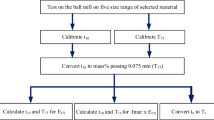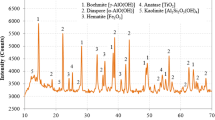Abstract
The main objective of batch grinding modeling is the estimation of the product particle size distribution over time or specific energy input to the mill. So far, the developed analytical methods require often complicated calculations which are time-consuming. Thus, more simple approaches that allow the reliable prediction of the complete product size distribution need to be developed. In the present paper, an approach, based on the population balance model (PBM), that reliably predicts the product size distribution is proposed. In order to enable this, the simplified form of the fundamental batch grinding equation was transformed into the well-known Rosin–Rammler (R-R) distribution, thus allowing the determination of the breakage rate for each grinding period. A time-dependent breakage rate framework was developed where the traditional linear theory of the PBM is considered a partial case. This approach allows the deviations from the linear theory to be categorized and the degree of the acceleration-deceleration of the breakage rate to be predicted. Modeling results were validated by laboratory grinding studies using two homogeneous materials, quartz and marble, and one heterogeneous, a limonitic laterite. The experimental data revealed that grinding exhibits non-first-order behavior and the degree of deviation from the linear theory depends on the tested material. The reliability of the proposed model was validated with the use of the distribution modulus n, the a value of the breakage rate parameter, and the optimum n values that minimize the sum of the differences between the experimental and estimated particle size distributions.







Similar content being viewed by others
References
Mystrioti C, Papassiopi N, Xernidis A, Komnitsas K (2018) Counter-current leaching of low-grade laterites with hydrochloric acid and proposed purification options of pregnant solution. Minerals 8(12):599
Gandhi SM, Sarkar BC (2016) Essentials of mineral exploration and evaluation. Elsevier, Alpharetta
Jeswiet J, Szekeres A (2016) Energy consumption in mining comminution. Procedia CIRP 48:140–145
Gharehgheshlagh HH, Ergun L, Chehreghani S (2017) Investigation of laboratory conditions effect on prediction accuracy of size distribution of industrial ball mill discharge by using a perfect mixing model. A case study: Ozdogu copper-molybdenum plant. Physicochem Probl Miner Process 53:1175–1187
Chimwani N, Mohale TM, Bwalya MM (2019) Tailoring ball mill feed size distribution for the production of a size-graded product. Miner Eng 141:105891
Fuerstenau DW, Lutch JJ, De A (1999) The effect of ball size on the energy efficiency of hybrid high-pressure roll mill/ball mill grinding. Powder Technol 105:199–204
Katubilwa FM, Moys MH (2009) Effect of ball size distribution on milling rate. Miner Eng 22:1283–1288
Deniz V (2012) The effects of ball filling and ball diameter on kinetic breakage parameters of barite powder. Adv Powder Technol 23:640–646
Deniz V (2013) Effects of mill speed on kinetic breakage parameters of four different particulate pumices. Part Sci Technol 31:101–108
Carvalho RM, Tavares M (2013) Predicting the effect of operating and design variables on breakage rates using the mechanistic ball mill model. Miner Eng 43–44:91–101
Petrakis E, Stamboliadis E, Komnitsas K (2017) Identification of optimal mill operating parameters during grinding of quartz with the use of population balance modelling. Kona Powder Part J 34:213–223
Rittinger PR (1867) Lehrbuch der Aufbereitungskunde. Ernst and Korn, Berlin
Kick F (1885) Das Gesetz der proportionalen Widerstände und seine Anwendungen. Felix, Leipzig
Bond FC (1952) The third theory of comminution. Trans Am Inst Min Metall Pet Eng 193:484–494
Walker WH, Lewis WK, McAdams WH, Gilliland ER (1937) Principles of chemical engineering, 3rd edn. McGraw Hill, New York
Austin LG, Klimpel RR, Luckie PT (1984) Process engineering of size reduction: ball milling. SME/AIME, New York
Kapur PC, Fuerstenau DW (1987) Energy-size reduction “Laws” revisited. Int J Miner Process 20:45–57
Stamboliadis E (2002) A contribution to the relationship of energy and particle size in the comminution of brittle particulate materials. Miner Eng 15:707–713
Gupta VK (2019) An appraisal of the energy-size reduction relationships for mill scale-up design. Adv Powder Technol 30:73–84
Charles RJ (1957) Energy–size reduction relationships in comminution. Trans AIME 208:80–88
Petrakis E, Stamboliadis E, Komnitsas K (2017) Evaluation of the relationship between energy input and particle size distribution in comminution with the use of piecewise regression analysis. Part Sci Technol 35:479–489
Papadopoulos DG, Ghadiri M (1996) Impact breakage of poly-methylmethacrylate (PMMA) extrudates: I. Chipping mechanism. Adv Powder Technol 7(3):183–197
Camalan M (2020) Correlating common breakage modes with impact breakage and ball milling of cement clinker and chromite. Int J Min Sci Technol 30:901–908. https://doi.org/10.1016/j.ijmst.2020.03.017
Manohar B, Sridhar BS (2001) Size and shape characterization of conventionally and cryogenically ground turmeric (Curcuma domestica) particles. Powder Technol 120:292–297
Yue J, Klein B (2005) Particle breakage kinetics in horizontal stirred mills. Miner Eng 18:325–331
Macías-García A, Cuerda-Correa EM, Díaz-Díez MA (2004) Application of the Rosin–Rammler and Gates–Gaudin–Schuhmann models to the particle size distribution analysis of agglomerated cork. Mater Charact 52:159–164
Taşdemir A, Taşdemir T (2009) A comparative study on PSD models for chromite ores comminuted by different devices. Part Part Syst Charact 26:69–79
Petrakis E, Karmali V, Bartzas G, Komnitsas K (2019) Grinding kinetics of slag and effect of final particle size on the compressive strength of alkali activated materials. Minerals 9:714
Hukki RT (1962) Proposal for a Solomonic settlement between the theories of Von Rittinger, kick and bond. Trans AIME 220:403–408
Morrell S (2004) An alternative energy-size relationship to that proposed by Bond for the design and optimization of grinding circuits. Int J Miner Process 74(1–4):133–141
Morrell S (2006) Rock characterisation for high pressure grinding rolls circuit design. In: Proceedings of autogenous and semi autogenous grinding technology (SAG) conference, Vancouver, Canada, pp 267–278
Kapur PC (1971) The energy-size reduction relationships in comminution of solids. Chem Eng Sci 26:11–16
Kapur PC (1972) Self-preserving size spectra of comminuted particles. Chem Eng Sci 27:425–431
Bilgili E (2007) On the consequences of non-first-order breakage kinetics in comminution processes: absence of self-similar size spectra. Part Part Syst Charact 24:12–17
Umucu Y, Deniz V, Bozkurt V, Çağlar MF (2016) The evaluation of grinding process using artificial neural network. Int J Miner Process 146:46–53
Singh V, Banerjee PK, Tripathy SK, Saxena VK, Venugopa R (2013) Artificial neural network modeling of ball mill grinding process. J Powder Metall Min 2:106
Cisternas LA, Lucay FA, Botero YL (2020) Trends in modeling, design, and optimization of multiphase systems in minerals processing. Minerals 10:22
Merma AG, Olivera CAC, Hacha RR, Torem ML, dos Santos BF (2019) Optimization of hematite and quartz bioflotation by an artificial neural network (ANN). J mater Technol 8:3076–3087
Wills BA, Finch J (2016) Will’s mineral processing technology. An introduction to the practical aspects of ore treatment and mineral recovery, 8th edn. Butterworth-Heinemann, Oxford
Lynch AJ (1977) Mineral crushing and grinding circuit—their simulation, optimisation, design and control. Elsevier, Amsterdam
Epstein B (1948) Logaritmico-normal distributions in breakage of solids. Ind Eng Chem 40:2289–2291
Broadbent SR, Callcott TG (1956) A matrix analysis of processes involving particle assemblies. Phil Trans R Soc Lond A 249:99–123
Bilgili E, Scarlett B (2005) Population balance modeling of non-linear effects in milling processes. Powder Technol 153:59–71
Deniz V, Onur T (2002) Investigation of the breakage kinetics of pumice samples as dependent on powder filling in a ball mill. Int J Miner Process 67:71–78
Fuerstenau DW, Kapur PC, De A (2003) Modelling breakage kinetics in various dry comminution systems. Kona Powder Part J 21:121–132
Chimwani N, Glasser D, Hildebrandt D, Metzger MJ, Mulenga FK (2013) Determination of the milling parameters of a platinum group minerals ore to optimize product size distribution for flotation purposes. Miner Eng 43-44:67–78
Celik MS (1988) Acceleration of breakage rates of anthracite during grinding in a ball mill. Powder Technol 54:227–233
Rajamani RK, Guo D (1992) Acceleration and deceleration of breakage rates in wet ball mills. Int J Miner Process 34:103–118
Capece M, Davé RN, Bilgili E (2015) On the origin of non-linear breakage kinetics in dry milling. Powder Technol 272:189–203
Gupta VK (2017) Effect of size distribution of the particulate material on the specific breakage rate of particles in dry ball milling. Powder Technol 305:714–722
Reid KJ (1965) A solution to the batch grinding equation. Chem Eng Sci 20:953–963
Kapur PC (1970) Kinetics of batch grinding: part B. An approximate solution to the grinding equation. Trans AIME 247:309–313
Nakajima Y, Tanaka T (1973) Solution of batch grinding equation. Ind Eng Chem Process Des Dev 12:23–25
Austin LG, Bagga P (1981) An analysis of fine dry grinding in ball mills. Powder Technol 28:83–90
Fuerstenau DW, Abouzeid A-ZM (1991) Effect of fine particles on the kinetics and energetics of grinding coarse particles. Int J Miner Process 31:151–162
Das PK, Khan AA, Pitchumani B (1995) Solution of the batch grinding equation. Powder Technol 85:189–192
Petrakis E, Karmali V, Komnitsas K (2018) Factors affecting nickel upgrade during selective grinding of low-grade limonitic laterites. Miner Process Ext Metall:1–10. https://doi.org/10.1080/25726641.2018.1521578
Tong L, Klein B, Zanin M, Quast K, Skinner W, Addai-Mensah J, Robinson D (2013) Stirred milling kinetics of siliceous goethitic nickel laterite for selective comminution. Miner Eng 49:109–115
Austin LG, Luckie PT (1972) Methods for determination of breakage distribution parameters. Powder Technol 5:215–222
Klimpel RR, Austin LG (1977) The back-calculation of specific rates of breakage and non-normalized breakage distribution parameters from batch grinding data. Int J Miner Process 4:7–32
Gupta VK, Zouit H, Hodouin D (1985) The effect of ball and mill diameters on grinding rate parameters in dry grinding operation. Powder Technol 42:199–208
Ozkan A, Yekeler M, Calkaya M (2009) Kinetics of fine wet grinding of zeolite in a steel ball mill in comparison to dry grinding. Int J Miner Process 90:67–73
Samanli S, Cuhadaroglu D, Ipek H, Ucbas Y (2010) The investigation of grinding kinetics of power plant solid fossil fuel in ball mill. Fuel 89:703–707
Herbst JA, Fuerstenau DW (1980) Scale-up procedure for continuous grinding mill design using population balance models. Int J Miner Process 7:1–31
Gupta VK, Sharma S (2014) Analysis of ball mill grinding operation using mill power specific kinetic parameters. Adv Powder Technol 25:625–634
Ipek H, Göktepe F (2011) Determination of grindability characteristics of zeolite. Physicochem Probl Miner Process 47:183–192
Wang X, Gui W, Yang C, Wang Y (2011) Wet grindability of an industrial ore and its breakage parameters estimation using population balances. Int J Miner Process 98:113–117
Deniz V (2013) Comparisons of dry grinding kinetics of lignite, bituminous coal and petroleum coke. Energy Sources Part A 35:913–920
Petrakis E, Komnitsas K (2019) Effect of energy input in a ball mill on dimensional properties of grinding products. Mining Metall Explor 36(4):803–816
Author information
Authors and Affiliations
Corresponding author
Ethics declarations
Conflict of Interest
The authors declare no competing interests.
Additional information
Publisher’s Note
Springer Nature remains neutral with regard to jurisdictional claims in published maps and institutional affiliations.
Rights and permissions
About this article
Cite this article
Petrakis, E., Komnitsas, K. Development of a Non-linear Framework for the Prediction of the Particle Size Distribution of the Grinding Products. Mining, Metallurgy & Exploration 38, 1253–1266 (2021). https://doi.org/10.1007/s42461-021-00388-w
Received:
Accepted:
Published:
Issue Date:
DOI: https://doi.org/10.1007/s42461-021-00388-w




